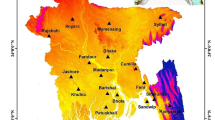Abstract
Dynamic changes in hydroclimatic variables (HC) and their effects on fluctuations of water-level (WL) are an important issue in order to properly manage available water resources. The present study presents an original view of the modeling of monthly WL fluctuations of Urmia Lake (UL), northwestern Iran, during 1986–2016. In order to study the nonlinear association between WL and HC, the hybrid of linear Autoregressive Moving Average with eXogenous variable (ARMAX) and nonlinear Generalized Autoregressive Conditional Heteroscedasticity (GARCH) as well as the multivariate GARCH (MGARCH) time series models are used. The fitted models identified streamflow, temperature, precipitation, wind speed, relative humidity, and day length as the affecting factors on the WL’s time-varying mean and variance. There are significant relationships between the dynamic behavior of conditional covariances of HC and WL, showing that WL depends relatively strong on weather conditions. The highest depth of memory in this dynamic process is related to streamflow. The results show that this association between HC and WL is more powerful when UL’s WL has been more than 1274 m and does not seem to change linearly through time. The results of this study are useful to understand UL’s WL dynamic behavior under the influence of weather conditions.









Similar content being viewed by others
References
Altunkaynak A (2007) Forecasting surface water-level fluctuations of Lake Van by artificial neural networks. Water Resour Manag 21(2):399–408
Altunkaynak A (2014) Predicting water level fluctuations in Lake Michigan-Huron using wavelet-expert system methods. Water Resour Manag 28(8):2293–2314
Arkian F, Nicholson SE, Ziaie B (2018) Meteorological factors affecting the sudden decline in Lake Urmia’s water-level. Theor Appl Climatol 131(1–2):641–651
Bollerslev T (1986) Generalized autoregressive conditional heteroscedasticity. J Econ 31(3):307–327
Bollerslev T, Engle RF, Wooldridge JM (1988) A capital asset pricing model with time varying covariances. J Polit Econ 96(1):116–131
Cengiz TM (2011) Periodic structures of great lakes levels using wavelet analysis. J Hyrol Hydromech 59(1):24–35
Çimen M, Kisi O (2009) Comparison of two different data-driven techniques in modeling lake level fluctuations in Turkey. J Hydrol 378(3):253–262
Dawson CW, Wilby RL (2001) Hydrological modeling using artificial neural networks. Prog Phys Geogr 25(1):80–108
Eimanifar A, Mohebbi F (2007) Urmia Lake (northwest Iran): a brief review. Saline Syst 3(5):1–8
Engle RF (1982) Autoregressive conditional heteroscedasticity with estimates of variance of United Kingdom inflation. Econometrica 50(4):987–1007
Engle RF (2002) Dynamic conditional correlation: a simple class of multivariate generalized autoregressive conditional heteroscedasticity models. J Fin Econom 2:531–564
Engle RF, Kroner KF (1995) Multivariate simultaneous multivariate ARCH. Econometric Theory 11(1):122–150
Fathian F, Dehghan Z, Eslamian S (2014) Analysis of water-level changes in Lake Urmia based on data characteristics and non-parametric test. Int J Hydrol Sci Technol 4(1):18–38
Fathian F, Morid S, Kahya E (2015) Identification of trends in hydrological and climatic variables in Urmia Lake basin, Iran. Theor Appl Climatol 119:443–464
Fathian F, Modarres R, Dehghan Z (2016) Urmia Lake water-level change detection and modeling. Model Earth Syst Environ 2(4):1–16
Francq C, Zakoian JM (2011) GARCH models: structure, statistical inference and financial applications. John Wiley & Sons, Ltd., United Kingdom
Güldal V, Tongal H (2010) Comparison of recurrent neural network, adaptive neuro-fuzzy inference system and stochastic models in Eğirdir lake level forecasting. Water Resour Manag 24(1):105–128
Hamilton JD (1994) Time series analysis. Princeton University Press
Hassanzadeh E, Zarghami M, Hassanzadeh Y (2012) Determining the main factors in declining the Urmia Lake level by using system dynamics modeling. Water Resour Manag 26:129–145
Hipel KW, McLeod AE (1996) Time series modeling of water resources and environmental systems. Elsevier, Amsterdam
Kakahaji H, Banadaki HD, Kakahaji A (2013) Prediction of Urmia Lake water-level fluctuations by using analytical, linear statistic and intelligent methods. Water Resour Manag 27(13):4469–4492
Kavehkar S, Ghorbani MA, Khokhlov V, Ashrafzadeh A, and Darbandi S (2011) Exploiting two intelligent models to predict water level: a field study of Urmia lake, Iran. Int J Civ Environ Eng 3(3):162–166
Kebede S, Travi Y, Alemayehu T, Marc V (2006) Water balance of Lake Tana and its sensitivity to fluctuations in rainfall, Blue Nile basin, Ethiopia. J Hydrol 316(1):233–247
Khazaei B, Khatami S, Alemohammad SH, Rashidi L, Wu C, Madani K, Aghakouchak A (2019) Climatic or regionally induced by humans? Tracing hydro-climatic and land-use changes to better understand the Lake Urmia tragedy. J Hydrol 569:203–217
Kisi O, Shiri J, Nikoofar B (2012) Forecasting daily lake levels using artificial intelligence approaches. Comput Geosci 41:169–180
Modarres R, Ouarda TBMJ (2013) Modeling rainfall–runoff relationship using multivariate GARCH model. J Hydrol 499:1–18
Modarres R, Ouarda TBMJ (2014) Modeling the relationship between climate oscillations and drought by a multivariate GARCH model. Water Resour Res 50(1):601–618
Modarres R, Ouarda TBMJ, Vanasse A, Orzanco MG, Gosselin P (2014) Modeling climate effects on hip fracture rate by the multivariate GARCH model in Montreal region, Canada. Int J Biometeorol 58(5):921–930
Talebizadeh M, Moridnejad A (2011) Uncertainty analysis for the forecast of lake level fluctuations using ensembles of ANN and ANFIS models. Expert Syst Appl 38(4):4126–4135
Tsay RS (2013) Multivariate time series analysis: with R and financial applications. John Wiley & Sons, Inc, Hoboken
UNEP G (2012) The drying of Iran's Lake Urmia and its environmental consequences. J Environ Dev 2(2):128–137
Author information
Authors and Affiliations
Corresponding author
Additional information
Publisher’s note
Springer Nature remains neutral with regard to jurisdictional claims in published maps and institutional affiliations.
Rights and permissions
About this article
Cite this article
Fathian, F. Dynamic memory of Urmia Lake water-level fluctuations in hydroclimatic variables. Theor Appl Climatol 138, 591–603 (2019). https://doi.org/10.1007/s00704-019-02844-6
Received:
Accepted:
Published:
Issue Date:
DOI: https://doi.org/10.1007/s00704-019-02844-6




